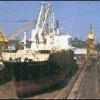
EPA Seeks To Set Tough Emission Standards for Large Ships
The U.S. Environmental Protection Agency (EPA) announced on July 1 a proposed rule under the Clean Air Act that sets tough engine and fuel standards for U.S. flagged ships.
According to the agency, the proposal is the next step in a coordinated strategy to slash harmful emissions from ocean-going vessels.
"These emissions are contributing to health, environmental and economic challenges for port communities and others that are miles inland," said EPA Administrator Lisa P. Jackson. "Lowering emissions from American ships will help safeguard our port communities, and demonstrate American leadership in protecting our health and the environment around the globe."
The rule comes on the heels of a key part of EPA's strategy, a proposal last March by the United States and Canada to designate thousands of miles of the two countries' coasts as an Emission Control Area (ECA). The International Maritime Organization (IMO), a United Nations agency, begins consideration of the ECA plan this month, which would result in stringent standards for large ships operating within 200 nautical miles of the coasts of Canada and the United States.
EPA is proposing to revise the CAA engine program to include two additional tiers of nitrogen oxide (NOx) standards for new Category 3 marine diesel engines installed on vessels flagged or registered in the United States. The proposed near-term Tier 2 standards for newly built engines would apply beginning in 2011 and would require more efficient use of current engine technologies. The Tier 2 standards would result in a 15 to 25 percent NOx reduction below the current Tier 1 levels. The proposed long-term Tier 3 standards would apply beginning in 2016 and would require the use of high efficiency after-treatment technology to achieve NOx reductions 80 percent below the current levels.
Air pollution from large ships, such as oil tankers and cargo ships, is expected to grow rapidly in line with port traffic increases, agency officials said. By 2030, the domestic and international strategy is expected to reduce annual emissions of NOx from large marine diesel engines by about 1.2 million tons and particulate matter (PM) emissions by about 143,000 tons. When fully implemented, the coordinated effort would reduce NOx emissions by 80 percent and PM emissions by 85 percent compared to current emissions.
Captain Charles D. Connor, U.S. Navy (Ret.), American Lung Association President and CEO, stated that: "In my career as a U.S. Navy Captain, I saw firsthand the staggering amounts of pollution that cruise ships, container ships, tankers and other ocean-going vessels released into the atmosphere. These ships dock at over 100 ports along our coastline and along navigable waterways far inland. Their smog-and soot-forming emissions threaten the health of those living far from our nation's maritime ports. By comparison, the U.S. Navy has made great strides to comply with the United States’ emission standards during normal operations."
The agency stated that emission reductions from the proposed strategy would yield significant health and welfare benefits that would span beyond U.S. ports and coastlines, reaching inland areas. EPA estimates that in 2030, this effort would prevent between 13,000 and 33,000 premature deaths, 1.5 million work days lost, and 10 million minor restricted-activity days. The estimated annual health benefits in 2030 as a result of reduced air pollution are valued between $110 and $280 billion at an annual projected cost of approximately $3.1 billion.
The proposed rulemaking is designed to reflect the IMO's stringent ECA standards and broader worldwide program. The agency stated that the rule represents another milestone in EPA's decade-long effort to reduce pollution from both new and existing diesel engines under the National Clean Diesel Campaign.
Environmental and health groups welcomed the announcement, but cautioned that more must be done. "EPA is finally recognizing that it's time to regulate the massive amounts of air pollution ships produce," said Jacqueline Savitz, Senior Campaign Director for Oceana. "Next they need to deal with carbon dioxide and other global warming pollution from ships because climate change is happening now, and we simply have no time to waste," she added.
Find more information on the components of the coordinated strategy on ocean-going vessels, including the proposed Clean Air Act standards and the ECA designation.